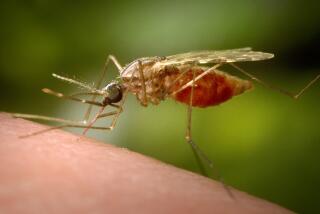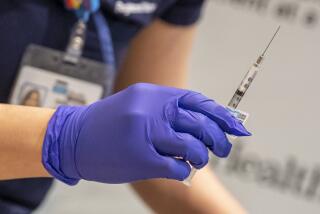A breakthrough in AIDS research
An effective vaccine against the AIDS virus may have moved one step closer to reality, researchers said Thursday.
Federal researchers have identified a pair of naturally occurring antibodies that are able to kill more than 90% of all strains of the AIDS virus, a finding they say could lead to the development of new treatments for HIV infections and to the production of the first successful vaccine against the virus.
HIV, the virus that causes AIDS, is notoriously mutable, changing the composition of proteins on its surface with ease to escape pressure from the immune system. This enables it to continue infecting cells even after the appearance of antibodies targeting it — and to avoid the relatively ineffective vaccines developed so far.
Hundreds of variants of the virus are now in circulation around the world, and the identification of so-called broadly neutralizing antibodies that can block the bulk of them has been the holy grail of HIV researchers.
To date, however, the best antibodies — immune system proteins that fight infections — that researchers have found block only 30% to 40% of all HIV strains. The identification of antibodies that can block more than 90% of strains could lead to what some researchers are dubbing a renaissance in AIDS prevention and treatment.
The key to the new antibodies is that they bind to a site on the virus surface that rarely mutates.
“I am more optimistic about an AIDS vaccine at this point in time than I have been probably in the last 10 years,” Dr. Gary Nabel of the National Institute of Allergy and Infectious Diseases told Reuters. He led the research reported Thursday in the online edition of the journal Science.
Nabel and his colleagues isolated the antibodies from the blood of a 60-year-old African American gay man. Using newly developed imaging and analytical techniques, they found that the two antibodies, called VRC01 and VRC02, bind to a spike on the surface of the virus. This spike interacts with a receptor called the CD4 binding site on the surface of human cells, and when an antibody binds to it, the virus cannot enter a cell.
Because the virus must use CD4 to enter cells, it cannot tolerate mutations in the spike. The composition of the spike is thus pretty much constant in all variants of HIV in circulation.
“The antibodies attach to a virtually unchanging part of the virus, and this explains why they can neutralize such an extraordinary range of HIV strains,” Dr. John R. Mascola of the infectious diseases institute, a coauthor, said in a statement.
With the antibodies in hand, the team was able to determine precisely how the HIV spike and the antibodies interact. They were then able to produce a synthetic version of the spike that could elicit the production of similar blocking antibodies in animal cells.
They are now testing the synthetic spike as a possible vaccine in animals and hope to expand to human testing in the relatively near future. The antibodies can also be reproduced by biotechnology and used as a treatment for someone who is already infected.
Researchers, who are already testing the antibodies in infected animals, hope that at the very least the antibodies will provide synergistic effects when used in conjunction with antiviral drugs.
Other researchers, such as Dennis Burton of the Scripps Research Institute in La Jolla, have also discovered broadly neutralizing antibodies, although most of the discoveries have not yet been published. Fortuitously, Mascola has found, antibodies discovered by Burton block viral variants that are not blocked by the antibodies reported Thursday.
Researchers thus hope that incorporating synthetic chemicals that stimulate production of several different antibodies might provide nearly complete protection against HIV.






